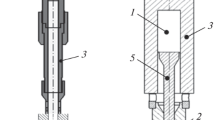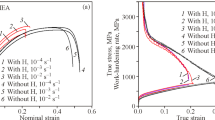Abstract
The specific features of the mechanodynamic penetration of helium under plastic deformation into fcc (Cu) and bcc (Fe, Nb) metals with different initial defect structures (single-crystal, nanocrystalline, and porous samples) are investigated. The intensity of mechanodynamic penetration into these metals is shown to depend on the type of bonding (metallic or covalent), which determines the degree of localization of the plastic flow of these metals, as well as on the type of defect structure and on the character of plastic flow (dislocation deformation, twinning, grain-boundary sliding). Curves of helium extraction from samples at different strains are obtained. It is found that the helium release exhibits a wide variety of peaks depending on the degree and character of plastic deformation of the metals under investigation. This suggests that the metals contain different types of helium traps, which determine the content of helium and the specific features of its release in the temperature range studied.
Similar content being viewed by others
References
O. V. Klyavin, N. P. Likhodedov, and A. N. Orlov, Prog. Surf. Sci. 33, 259 (1990).
O. V. Klyavin, Fiz. Tverd. Tela (St. Petersburg) 35(3), 513 (1993) [Phys. Solid State 35 (3), 261 (1993)].
O. V. Klyavin, B. A. Mamyrin, L. V. Khabarin, and Yu. M. Chernov, Fiz. Tverd. Tela (St. Petersburg) 47(5), 837 (2005) [Phys. Solid State 47 (5), 863 (2005)].
O. V. Klyavin, V. I. Nikolaev, L. V. Khabarin, Yu. M. Chernov, and V. V. Shpeĭzman, Fiz. Tverd. Tela (St. Petersburg) 45(12), 2187 (2003) [Phys. Solid State 45 (12), 2292 (2003)].
O. V. Klyavin, V. I. Nikolaev, B. I. Smirnov, L. V. Khabarin, Yu. M. Chernov, and V. V. Shpeĭzman, Fiz. Tverd. Tela (St. Petersburg) 50(5), 794 (2008) [Phys. Solid State 50 (5), 828 (2008)].
I. I. Novikov, Defects in the Crystal Structure of Metals (Metallurgiya, Moscow, 1968) [in Russian].
A. I. Petrov, M. V. Razuvaeva, A. B. Sinani, and V. V. Nikitin, Zh. Tekh. Fiz. 68(11), 125 (1998) [Tech. Phys. 43 (11), 1385 (1998)].
O. V. Klyavin, V. I. Nikolaev, B. I. Smirnov, L. V. Khabarin, Yu. M. Chernov, and V. V. Shpeĭzman, Fiz. Tverd. Tela (St. Petersburg) 49(9), 1590 (2007) [Phys. Solid State 49 (9), 1666 (2007)].
V. V. Shpeĭzman, V. I. Nikolaev, B. I. Smirnov, A. B. Lebedev, and V. I. Kopylov, Fiz. Tverd. Tela (St. Petersburg) 42(6), 1034 (2000) [Phys. Solid State 42 (6), 1066 (2000)].
Author information
Authors and Affiliations
Corresponding author
Additional information
Original Russian Text © O.V. Klyavin, V.I. Nikolaev, B.I. Smirnov, L.V. Khabarin, Yu.M. Chernov, V.V. Shpeĭzman, 2008, published in Fizika Tverdogo Tela, 2008, Vol. 50, No. 8, pp. 1402–1407.
Rights and permissions
About this article
Cite this article
Klyavin, O.V., Nikolaev, V.I., Smirnov, B.I. et al. Influence of the defect and structural state of FCC and BCC metals on the intensity of mechanodynamic penetration of helium atoms. Phys. Solid State 50, 1458–1463 (2008). https://doi.org/10.1134/S106378340808012X
Received:
Published:
Issue Date:
DOI: https://doi.org/10.1134/S106378340808012X




